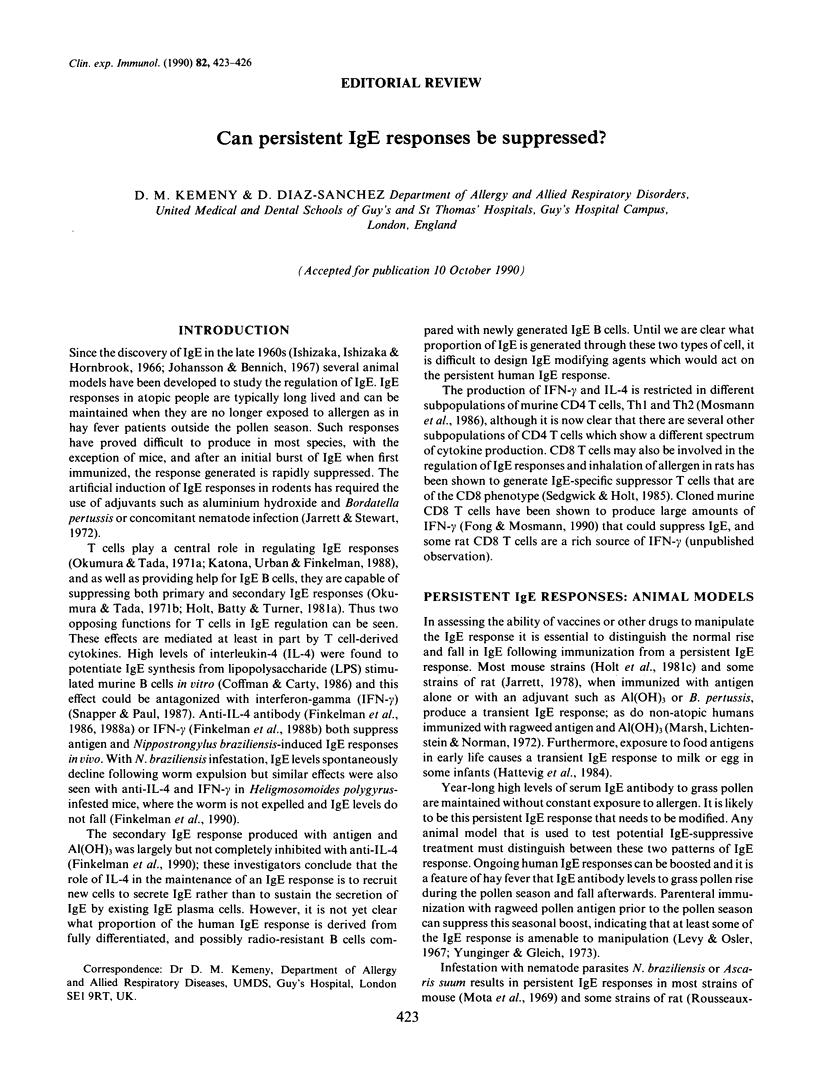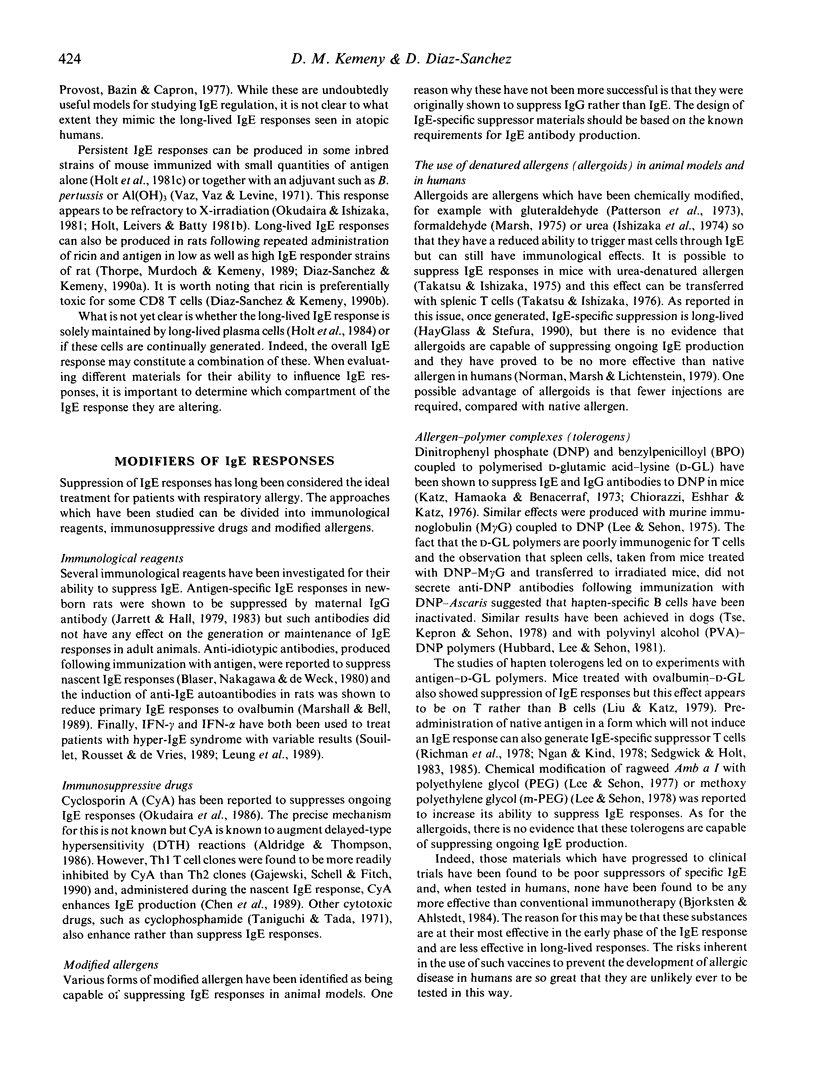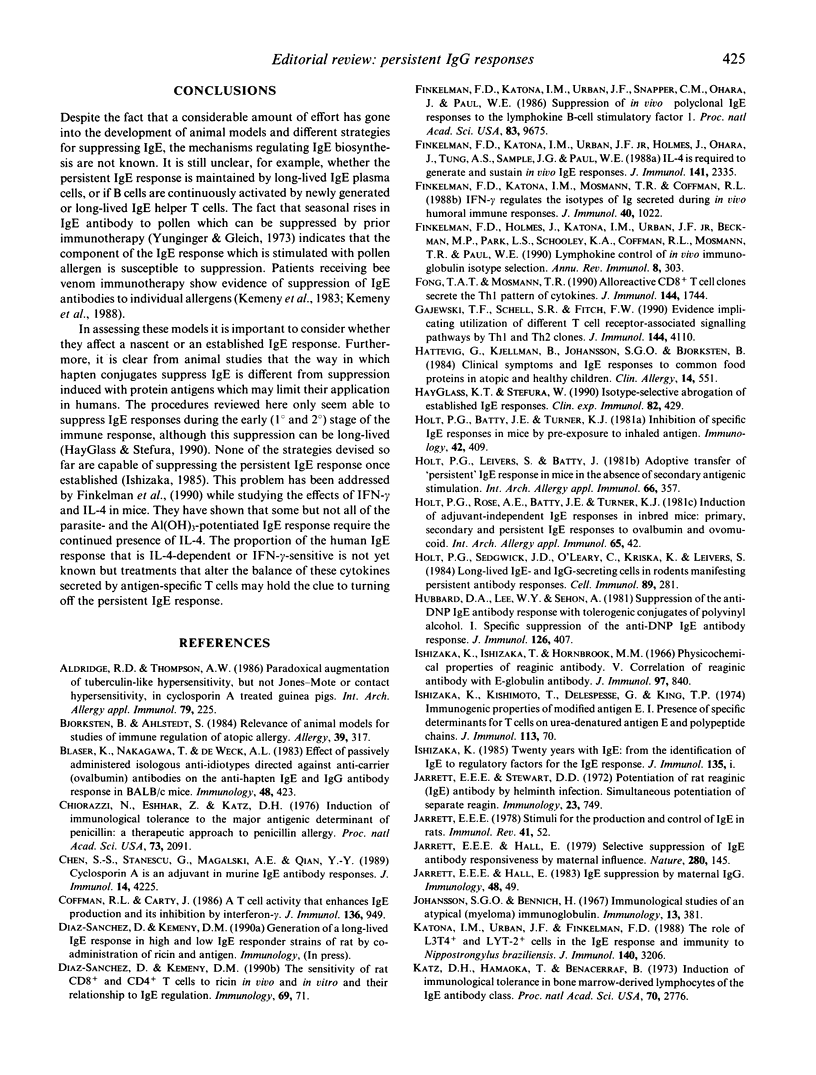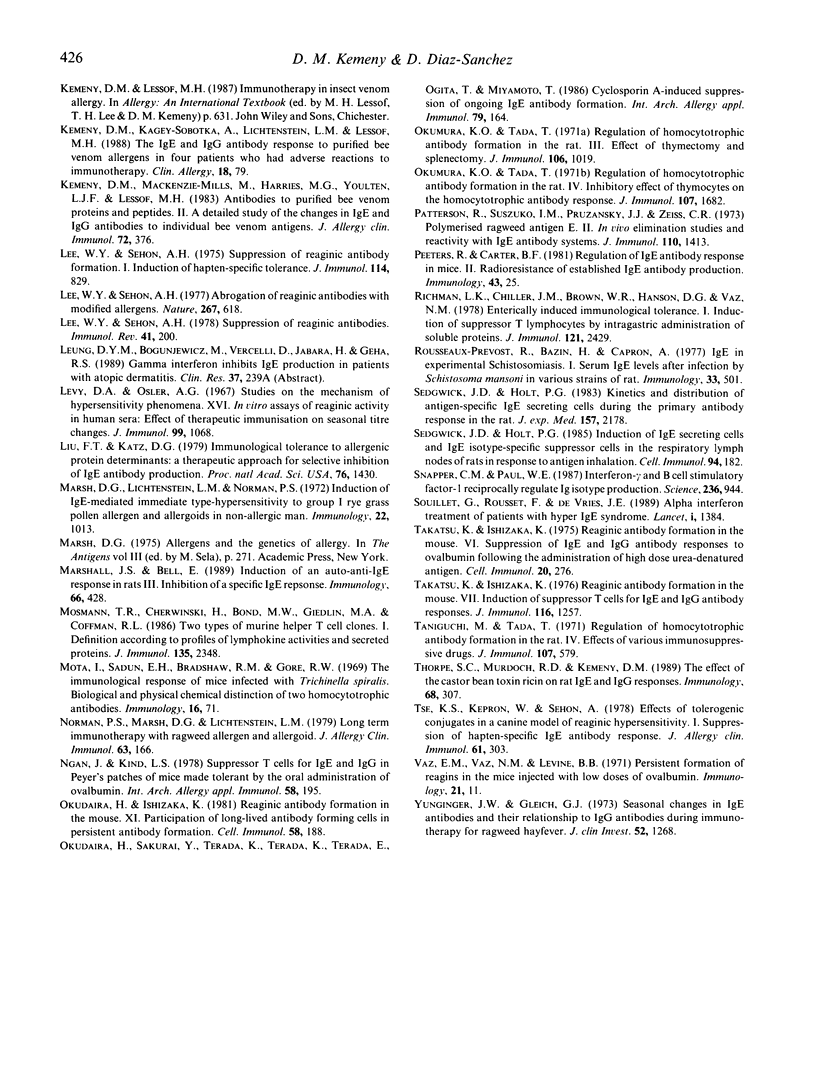Full text
PDF



Selected References
These references are in PubMed. This may not be the complete list of references from this article.
- Aldridge R. D., Thomson A. W. Paradoxical augmentation of tuberculin-like hypersensitivity, but not Jones-Mote or contact hypersensitivity, in cyclosporin A treated guinea pigs. Int Arch Allergy Appl Immunol. 1986;79(3):225–230. doi: 10.1159/000233977. [DOI] [PubMed] [Google Scholar]
- Björkstén B., Ahlstedt S. Relevance of animal models for studies of immune regulation of atopic allergy. Allergy. 1984 Jul;39(5):317–327. doi: 10.1111/j.1398-9995.1984.tb01949.x. [DOI] [PubMed] [Google Scholar]
- Blaser K., Nakagawa T., De Weck A. L. Effect of passively administered isologous anti-idiotypes directed against anti-carrier (ovalbumin) antibodies on the anti-hapten IgE and IgG antibody responses in BALB/c mice. Immunology. 1983 Mar;48(3):423–431. [PMC free article] [PubMed] [Google Scholar]
- Chen S. S., Stanescu G., Magalski A. E., Qian Y. Y. Cyclosporin A is an adjuvant in murine IgE antibody responses. J Immunol. 1989 Jun 15;142(12):4225–4232. [PubMed] [Google Scholar]
- Chiorazzi N., Eshhar Z., Katz D. H. Induction if immunological tolerance to the major antigenic determinant of penicillin: a therapeutic approach to penicillin allergy. Proc Natl Acad Sci U S A. 1976 Jun;73(6):2091–2095. doi: 10.1073/pnas.73.6.2091. [DOI] [PMC free article] [PubMed] [Google Scholar]
- Coffman R. L., Carty J. A T cell activity that enhances polyclonal IgE production and its inhibition by interferon-gamma. J Immunol. 1986 Feb 1;136(3):949–954. [PubMed] [Google Scholar]
- Diaz-Sanchez D., Kemeny D. M. The sensitivity of rat CD8+ and CD4+ T cells to ricin in vivo and in vitro and their relationship to IgE regulation. Immunology. 1990 Jan;69(1):71–77. [PMC free article] [PubMed] [Google Scholar]
- Finkelman F. D., Holmes J., Katona I. M., Urban J. F., Jr, Beckmann M. P., Park L. S., Schooley K. A., Coffman R. L., Mosmann T. R., Paul W. E. Lymphokine control of in vivo immunoglobulin isotype selection. Annu Rev Immunol. 1990;8:303–333. doi: 10.1146/annurev.iy.08.040190.001511. [DOI] [PubMed] [Google Scholar]
- Finkelman F. D., Katona I. M., Mosmann T. R., Coffman R. L. IFN-gamma regulates the isotypes of Ig secreted during in vivo humoral immune responses. J Immunol. 1988 Feb 15;140(4):1022–1027. [PubMed] [Google Scholar]
- Finkelman F. D., Katona I. M., Urban J. F., Jr, Holmes J., Ohara J., Tung A. S., Sample J. V., Paul W. E. IL-4 is required to generate and sustain in vivo IgE responses. J Immunol. 1988 Oct 1;141(7):2335–2341. [PubMed] [Google Scholar]
- Finkelman F. D., Katona I. M., Urban J. F., Jr, Snapper C. M., Ohara J., Paul W. E. Suppression of in vivo polyclonal IgE responses by monoclonal antibody to the lymphokine B-cell stimulatory factor 1. Proc Natl Acad Sci U S A. 1986 Dec;83(24):9675–9678. doi: 10.1073/pnas.83.24.9675. [DOI] [PMC free article] [PubMed] [Google Scholar]
- Fong T. A., Mosmann T. R. Alloreactive murine CD8+ T cell clones secrete the Th1 pattern of cytokines. J Immunol. 1990 Mar 1;144(5):1744–1752. [PubMed] [Google Scholar]
- Gajewski T. F., Schell S. R., Fitch F. W. Evidence implicating utilization of different T cell receptor-associated signaling pathways by TH1 and TH2 clones. J Immunol. 1990 Jun 1;144(11):4110–4120. [PubMed] [Google Scholar]
- Hattevig G., Kjellman B., Johansson S. G., Björkstén B. Clinical symptoms and IgE responses to common food proteins in atopic and healthy children. Clin Allergy. 1984 Nov;14(6):551–559. doi: 10.1111/j.1365-2222.1984.tb02243.x. [DOI] [PubMed] [Google Scholar]
- HayGlass K. T., Stefura W. Isotype-selective abrogation of established IgE responses. Clin Exp Immunol. 1990 Dec;82(3):429–434. doi: 10.1111/j.1365-2249.1990.tb05466.x. [DOI] [PMC free article] [PubMed] [Google Scholar]
- Holt P. G., Batty J. E., Turner K. J. Inhibition of specific IgE responses in mice by pre-exposure to inhaled antigen. Immunology. 1981 Mar;42(3):409–417. [PMC free article] [PubMed] [Google Scholar]
- Holt P. G., Leivers S., Batty J. Adoptive transfer of "persistent' IgE responses in mice in the absence of secondary antigenic stimulation. Int Arch Allergy Appl Immunol. 1981;66(4):357–364. doi: 10.1159/000232844. [DOI] [PubMed] [Google Scholar]
- Holt P. G., Rose A. H., Batty J. E., Turner K. J. Induction of adjuvant-independent IgE responses in inbred mice: primary, secondary, and persistent IgE responses to ovalbumin and ovomucoid. Int Arch Allergy Appl Immunol. 1981;65(1):42–50. doi: 10.1159/000232736. [DOI] [PubMed] [Google Scholar]
- Holt P. G., Sedgwick J. D., O'Leary C., Krska K., Leivers S. Long-lived IgE- and IgG-secreting cells in rodents manifesting persistent antibody responses. Cell Immunol. 1984 Dec;89(2):281–289. doi: 10.1016/0008-8749(84)90330-7. [DOI] [PubMed] [Google Scholar]
- Hubbard D. A., Lee W. Y., Sehon A. H. Suppression of the anti-DNP IgE response with tolerogenic conjugates of DNP with polyvinyl alcohol. I. Specific suppression of the anti-DNP IgE response. J Immunol. 1981 Feb;126(2):407–413. [PubMed] [Google Scholar]
- Ishizaka K., Ishizaka T., Hornbrook M. M. Physicochemical properties of reaginic antibody. V. Correlation of reaginic activity wth gamma-E-globulin antibody. J Immunol. 1966 Dec;97(6):840–853. [PubMed] [Google Scholar]
- Ishizaka K., Kishimoto T., Delespesse G., King T. P. Immunogenic properties of modified antigen E. I. Presence of specific determinants for T cells in denatured antigen and polypeptide chains. J Immunol. 1974 Jul;113(1):70–77. [PubMed] [Google Scholar]
- Ishizaka K. Twenty years with IgE: from the identification of IgE to regulatory factors for the IgE response. J Immunol. 1985 Jul;135(1):i–x. [PubMed] [Google Scholar]
- Jarrett E. E., Hall E. IgE suppression by maternal IgG. Immunology. 1983 Jan;48(1):49–58. [PMC free article] [PubMed] [Google Scholar]
- Jarrett E. E., Stewart D. C. Potentiation of rat reaginic (IgE) antibody by helminth infection. Simultaneous potentiation of separate reagins. Immunology. 1972 Nov;23(5):749–755. [PMC free article] [PubMed] [Google Scholar]
- Jarrett E. E. Stimuli for the production and control of IgE in rats. Immunol Rev. 1978;41:52–76. doi: 10.1111/j.1600-065x.1978.tb01460.x. [DOI] [PubMed] [Google Scholar]
- Jarrett E., Hall E. Selective suppression of IgE antibody responsiveness by maternal influence. Nature. 1979 Jul 12;280(5718):145–147. doi: 10.1038/280145a0. [DOI] [PubMed] [Google Scholar]
- Johansson S. G., Bennich H. Immunological studies of an atypical (myeloma) immunoglobulin. Immunology. 1967 Oct;13(4):381–394. [PMC free article] [PubMed] [Google Scholar]
- Katona I. M., Urban J. F., Jr, Finkelman F. D. The role of L3T4+ and Lyt-2+ T cells in the IgE response and immunity to Nippostrongylus brasiliensis. J Immunol. 1988 May 1;140(9):3206–3211. [PubMed] [Google Scholar]
- Katz D. H., Hamaoka T., Benacerraf B. Induction of immunological tolerance in bone marrow-derived lymphocytes of the IgE antibody class. Proc Natl Acad Sci U S A. 1973 Oct;70(10):2776–2780. doi: 10.1073/pnas.70.10.2776. [DOI] [PMC free article] [PubMed] [Google Scholar]
- Kemeny D. M., Kagey-Sobotka A., Lichtenstein L. M., Lessof M. H. IgE and IgG antibody response to purified bee-venom antigens and peptides in four patients who had adverse reactions to immunotherapy. Clin Allergy. 1988 Jan;18(1):79–84. doi: 10.1111/j.1365-2222.1988.tb02846.x. [DOI] [PubMed] [Google Scholar]
- Kemeny D. M., MacKenzie-Mills M., Harries M. G., Youlten L. J., Lessof M. H. Antibodies to purified bee venom proteins and peptides. II. A detailed study of changes in IgE and IgG antibodies to individual bee venom antigens. J Allergy Clin Immunol. 1983 Oct;72(4):376–385. doi: 10.1016/0091-6749(83)90503-1. [DOI] [PubMed] [Google Scholar]
- Lee W. Y., Sehon A. H. Abrogation of reaginic antibodies with modified allergens. Nature. 1977 Jun 16;267(5612):618–619. doi: 10.1038/267618a0. [DOI] [PubMed] [Google Scholar]
- Lee W. Y., Sehon A. H. Suppression of reaginic antibodies. Immunol Rev. 1978;41:200–247. doi: 10.1111/j.1600-065x.1978.tb01466.x. [DOI] [PubMed] [Google Scholar]
- Lee W. Y., Sehon A. H. Suppression of reaginic antibody formation. I. Induction of hapten-specific tolerance. J Immunol. 1975 Feb;114(2 Pt 2):829–836. [PubMed] [Google Scholar]
- Levy D. A., Osler A. G. Studies on the mechanisms of hypersensitivity phenomena. XVI. In vitro assays of reaginic activity in human sera: effect of therapeutic immunization on seasonal titer changes. J Immunol. 1967 Dec;99(6):1068–1077. [PubMed] [Google Scholar]
- Liu F. T., Katz D. H. Immunological tolerance to allergenic protein determinants: a therapeutic approach for selective inhibition of IgE antibody production. Proc Natl Acad Sci U S A. 1979 Mar;76(3):1430–1434. doi: 10.1073/pnas.76.3.1430. [DOI] [PMC free article] [PubMed] [Google Scholar]
- Marsh D. G., Lichtenstein L. M., Norman P. S. Induction of IgE-mediated immediate hypersensitivity to group I rye grass pollen allergen and allergoids in non-allergic man. Immunology. 1972 Jun;22(6):1013–1028. [PMC free article] [PubMed] [Google Scholar]
- Marshall J. S., Bell E. B. Induction of an auto-anti-IgE response in rats. III. Inhibition of a specific IgE response. Immunology. 1989 Mar;66(3):428–433. [PMC free article] [PubMed] [Google Scholar]
- Mosmann T. R., Cherwinski H., Bond M. W., Giedlin M. A., Coffman R. L. Two types of murine helper T cell clone. I. Definition according to profiles of lymphokine activities and secreted proteins. J Immunol. 1986 Apr 1;136(7):2348–2357. [PubMed] [Google Scholar]
- Mota I., Sadun E. H., Bradshaw R. M., Gore R. W. The immunological response of mice infected with Trichinella spiralis. Biological and physico-chemical distinction of two homocytotropic antibodies. Immunology. 1969 Jan;16(1):71–81. [PMC free article] [PubMed] [Google Scholar]
- Ngan J., Kind L. S. Suppression of IgE antibody formation in mice: requirement for T-T lymphocyte interaction. Int Arch Allergy Appl Immunol. 1979;58(2):195–201. doi: 10.1159/000232192. [DOI] [PubMed] [Google Scholar]
- Okudaira H., Ishizaka K. Reaginic antibody formation in the mouse. XI. Participation of long-lived antibody-forming cells in persistent antibody formation. Cell Immunol. 1981 Feb;58(1):188–201. doi: 10.1016/0008-8749(81)90160-x. [DOI] [PubMed] [Google Scholar]
- Okudaira H., Sakurai Y., Terada K., Terada E., Ogita T., Miyamoto T. Cyclosporin A-induced suppression of ongoing IgE antibody formation in the mouse. Int Arch Allergy Appl Immunol. 1986;79(2):164–168. doi: 10.1159/000233965. [DOI] [PubMed] [Google Scholar]
- Okumura K., Tada T. Regulation of homocytotropic antibody formation in the rat. 3. Effect of thymectomy and splenectomy. J Immunol. 1971 Apr;106(4):1019–1025. [PubMed] [Google Scholar]
- Okumura K., Tada T. Regulation of homocytotropic antibody formation in the rat. VI. Inhibitory effect of thymocytes on the homocytotropic antibody response. J Immunol. 1971 Dec;107(6):1682–1689. [PubMed] [Google Scholar]
- Patterson R., Suszko I. M., Pruzansky J. J., Zeiss C. R. Polymerized ragweed antigen e. ii. in vivo elimination studies and reactivity with IgE antibody systems. J Immunol. 1973 May;110(5):1413–1418. [PubMed] [Google Scholar]
- Peeters S. H., Carter B. G. Regulation of the IgE antibody response in mice. II. Radioresistance of established IgE antibody production. Immunology. 1981 May;43(1):25–32. [PMC free article] [PubMed] [Google Scholar]
- Richman L. K., Chiller J. M., Brown W. R., Hanson D. G., Vaz N. M. Enterically induced immunologic tolerance. I. Induction of suppressor T lymphoyctes by intragastric administration of soluble proteins. J Immunol. 1978 Dec;121(6):2429–2434. [PubMed] [Google Scholar]
- Rousseaux-Prevost R., Bazin H., Capron A. IgE in experiemental schistosomiasis. I. Serum IgE levels after infection by Schistosoma mansoni in various strains of rats. Immunology. 1977 Oct;33(4):501–505. [PMC free article] [PubMed] [Google Scholar]
- Sedgwick J. D., Holt P. G. Induction of IgE-secreting cells and IgE isotype-specific suppressor T cells in the respiratory lymph nodes of rats in response to antigen inhalation. Cell Immunol. 1985 Aug;94(1):182–194. doi: 10.1016/0008-8749(85)90095-4. [DOI] [PubMed] [Google Scholar]
- Sedgwick J. D., Holt P. G. Kinetics and distribution of antigen-specific IgE-secreting cells during the primary antibody response in the rat. J Exp Med. 1983 Jun 1;157(6):2178–2183. doi: 10.1084/jem.157.6.2178. [DOI] [PMC free article] [PubMed] [Google Scholar]
- Snapper C. M., Paul W. E. Interferon-gamma and B cell stimulatory factor-1 reciprocally regulate Ig isotype production. Science. 1987 May 22;236(4804):944–947. doi: 10.1126/science.3107127. [DOI] [PubMed] [Google Scholar]
- Souillet G., Rousset F., de Vries J. E. Alpha-interferon treatment of patient with hyper IgE syndrome. Lancet. 1989 Jun 17;1(8651):1384–1384. doi: 10.1016/s0140-6736(89)92823-7. [DOI] [PubMed] [Google Scholar]
- Takatsu K., Ishizaka K. Reaginic antibody formation in the mouse. VI. Suppression of IgE and IgG antibody responses to ovalbumin following the administration of high dose urea-denatured antigen. Cell Immunol. 1975 Dec;20(2):276–289. doi: 10.1016/0008-8749(75)90105-7. [DOI] [PubMed] [Google Scholar]
- Takatsu K., Ishizaka K. Reaginic antibody formation in the mouse. VII. Induction of suppressor T cells for IgE and IgG antibody responses. J Immunol. 1976 May;116(5):1257–1264. [PubMed] [Google Scholar]
- Taniguchi M., Tada T. Regulation of homocytotropic antibody formation in the rat. IV. Effects of various immunosuppressive drugs. J Immunol. 1971 Aug;107(2):579–585. [PubMed] [Google Scholar]
- Thorpe S. C., Murdoch R. D., Kemeny D. M. The effect of the castor bean toxin, ricin, on rat IgE and IgG responses. Immunology. 1989 Nov;68(3):307–311. [PMC free article] [PubMed] [Google Scholar]
- Tse K. S., Kepron W., Sehon A. Effects of tolerogenic conjugates in a canine model for reaginic hypersensitivity. I. suppression of hapten-specific IgE antibody response. J Allergy Clin Immunol. 1978 May;61(5):303–309. doi: 10.1016/0091-6749(78)90051-9. [DOI] [PubMed] [Google Scholar]
- Vaz E. M., Vaz N. M., Levine B. B. Persistent formation of reagins in mice injected with low doses of ovalbuminl. Immunology. 1971 Jul;21(1):11–15. [PMC free article] [PubMed] [Google Scholar]
- Yunginger J. W., Gleich G. J. Seasonal changes in IgE antibodies and their relationship to IgG antibodies during immunotherapy for ragweed hay fever. J Clin Invest. 1973 May;52(5):1268–1275. doi: 10.1172/JCI107294. [DOI] [PMC free article] [PubMed] [Google Scholar]


